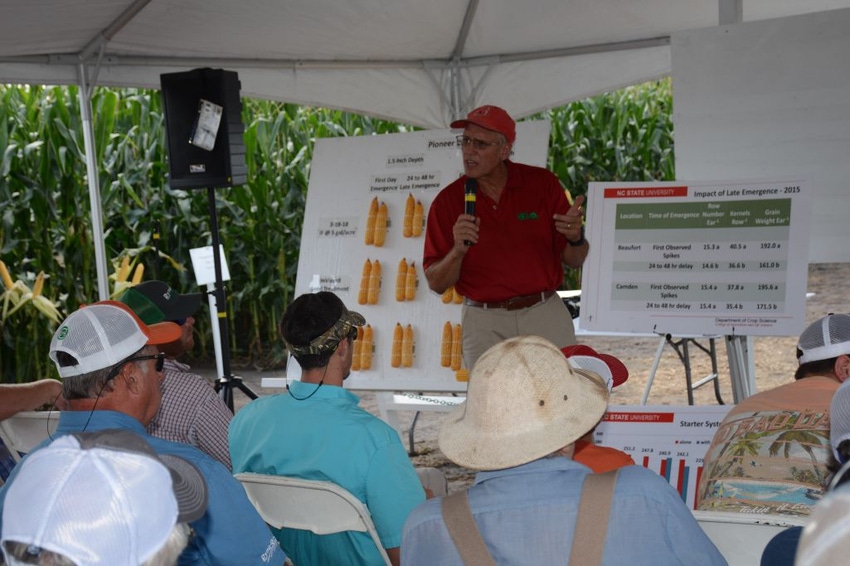
As the new year began, North Carolina State University Extension Corn Specialist Ron Heiniger boldly proclaimed 2016 as “the year of the corn” because this would be the year North Carolina would make a record corn crop.
“Overall, statewide, this is going to be our best crop ever,” Heiniger says. “There are spots in the Coastal Plain where farmers have never seen anything like this: corn that is 16 feet tall with big ears.”
In winter meetings this year, Heiniger predicted North Carolina corn farmers would make an average statewide record yield of 150 bushels per acre. “It’s still too early to tell, but I think we will still make that record yield of 150 bushels per acre,” the corn specialist said.
North Carolina’s previous record corn crop was set in 2013 with an average statewide yield of 142 bushels per acre.
Heiniger credits North Carolina farmers for doing what needed to be done to make top yields this year. “You guys did all the right things to make a good crop,” Heiniger said at this year’s Blacklands Farm Managers Tour held Aug. 3 at Middle Creek Farms in Englehard, N.C.
Heiniger said there are some imperfections in “the year of the corn” in North Carolina such as very dry weather in Johnston County that will reduce the crop there, but most of the state is on tap to break yield records.
In fact, Heiniger is confident some farmers in the blacklands region of the state will make a staggering 500 bushels per acre. It “That’s the kind of corn that just knocks your socks off. It runs through the combine like water,” he said.
In the winter meetings, Heiniger explained that the El Nino weather pattern would make for ideal corn growing conditions across the state this year. El Nino means warm temperatures in the central Pacific and it impacts the weather globally. For North Carolina, it makes for a wet, cool fall and winter extreme, an extreme warm and dry spring and an extreme dry late summer. For corn, this is a good thing, Heiniger says.
The weather was warm and dry in April and May which made for ideal planting conditions with timely rain in June all the way to pollination. These conditions are ideal for good corn yields, Heiniger says.
Principles for higher corn yields
At the Blacklands tour, Heiniger outlined some of the principles for achieving high corn yields. As he emphasized in prior meetings, Heiniger pointed to uniform emergence and rapid growth from emergence to V6 as vital for top yields.
“If you’re making big corn, you’re worried about kernels. That’s what you are growing and selling; it’s kernels per acre. The more kernels per acre you can glean, the better off you are in making big yields and the potential for better profit,” Heiniger emphasized.
Heiniger noted late emerging ears don’t put on as many kernels per ear, which is why uniform emergence is critical.
“If you can plant in a situation where we have good uniform moisture, even if it’s a cooler soil, I think our ability to get these plants up is enhanced whereas if we’re planting in front of a cold rain, we’re going to see some negative impacts on emergence,” Heiniger explained.
Also, Heiniger advises farmers to plant deeper at 2.5 inches compared to 1.5 inches for the best yields. “Deeper is better. I think there are some carryover effects on making more kernels and making plants more tolerant of stress. Deeper planting has some real benefits in getting corn emerged and getting it to V7 in a uniform stage,” he said.
“After the corn is emerged, we want it to never stop growing,” he added. “I asked every grower this year who has taken me to a field with big 14 foot corn plants how they did this, and they all said that when the corn came out of the ground, it never stopped growing.”
Heiniger said starter fertilizer is vital for top yields, but not at levels too high that it burns the crop.
“You need to know what your nutrients are and what your corn is going to need to keep that growth going and you need to supply those nutrients,” he stressed. “Whatever direction or starter material you think you need, find it. That takes a little work to experiment and it is certainly different for different soils.”
In addition to nitrogen, Heiniger said high yielding corn needs both zinc and magnesium. Phosphorus and potassium are also important as well. “Phosphorous is critical, particularly in cool weather to help that plant take up nitrogen. Potassium is critical, particularly as we get into grain fill,” he noted.
“I really want my potassium and nitrogen rations in my tissue samples to be very close to one-to-one, particularly as I come close to silking time. I want plenty of potassium so when it gets to 100 degrees, that potassium is helping that plant transpire water,” Heiniger emphasized.

The 46th annual Blacklands Farm Managers Tour drew a crowd of 400 to Middle Creek Farms in Engehard, N.C.
About the Author(s)
You May Also Like






